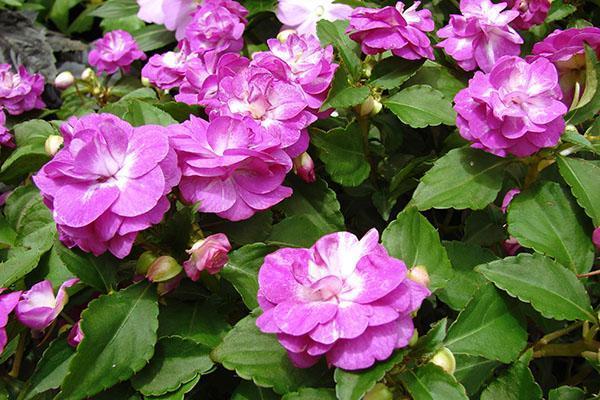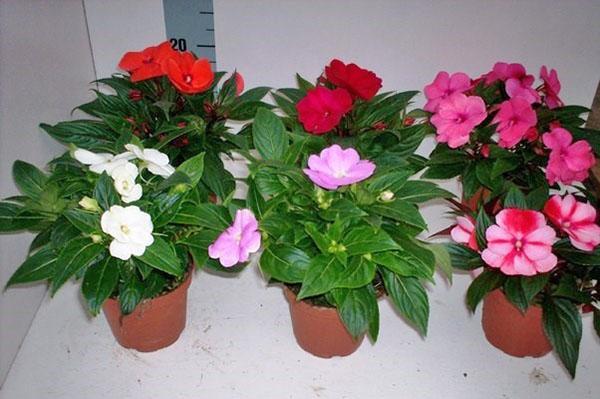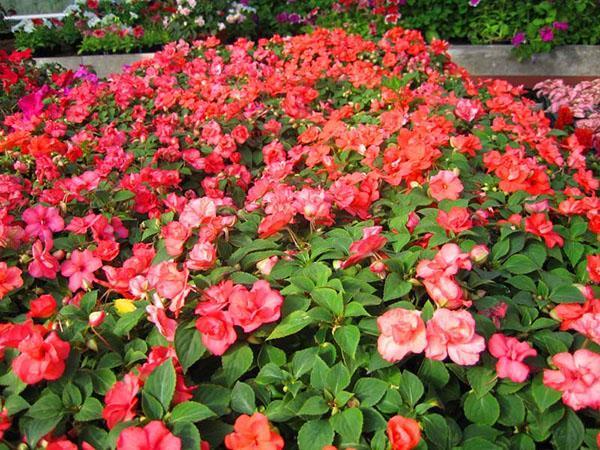Caring for balsam at home
 Balsam is a beautiful, abundantly and brightly blooming, potted flower that does not require special attention, which came to us from the islands of Zanzibar. Its homeland is also considered the subtropics of Africa and the countries of Central Asia. In the CIS, this houseplant is better known under other names: "Wet Vanka", "Ogonyok" and "Impatient". The balsam family includes about 500 plant species, which have a number of specific features - a love of moisture and sunlight. In order for balsam to bloom profusely and brightly, caring for it at home should take into account regular and correct watering, as well as placement in the room. What do you need to know about breeding this plant? What are the features of care?
Balsam is a beautiful, abundantly and brightly blooming, potted flower that does not require special attention, which came to us from the islands of Zanzibar. Its homeland is also considered the subtropics of Africa and the countries of Central Asia. In the CIS, this houseplant is better known under other names: "Wet Vanka", "Ogonyok" and "Impatient". The balsam family includes about 500 plant species, which have a number of specific features - a love of moisture and sunlight. In order for balsam to bloom profusely and brightly, caring for it at home should take into account regular and correct watering, as well as placement in the room. What do you need to know about breeding this plant? What are the features of care?
Read also: how to care for garden balsam?
The appearance of balsam: a photo of indoor plants and a description

 This is what a room balsam looks like — the photos were taken during the period of abundant flowering.
This is what a room balsam looks like — the photos were taken during the period of abundant flowering.
Annual representatives are grown in the open field. The care requirements will be the same.
Both types of plants can bloom as inflorescences and single flowers, the petals of which have a characteristic bright color: snow-white, matte pink, scarlet, bright orange (fiery) and others.
 The beauty of flowers in an unusual petal shape:
The beauty of flowers in an unusual petal shape:
- freely located;
- accreted in pairs;
- the presence of one petal elongated into the spur in the inflorescence;
- multicolor color: pink-burgundy, yellow-purple, white-purple and other shades;
- small white bud, opening with large, bright and rich petals.
The perennial species blooms profusely practically all year round. But only if the balsamic care at home was correct - the photo shows healthy plants from both subspecies. If an annual representative of the family is grown in a pot, then he will delight with large flowers in the summer. With good care, the flowering period is extended by 1-1.5.
How to choose the right place for indoor balsam: photos and rules
 All representatives of the balsamic family are light-loving herbaceous plants. If the house has a south-facing window, that is their place. But when placing the pot on the windowsill, it is worth considering that direct sunlight shining through the glass can scorch the juicy and bright leaves. In order to ensure proper care for indoor balsam during the summer heat, it is necessary to put protection or choose an area on the windowsill where the sun's rays linger for a short time. With the arrival of cold weather, the protection must be removed and the pot placed in the most lighted place.
All representatives of the balsamic family are light-loving herbaceous plants. If the house has a south-facing window, that is their place. But when placing the pot on the windowsill, it is worth considering that direct sunlight shining through the glass can scorch the juicy and bright leaves. In order to ensure proper care for indoor balsam during the summer heat, it is necessary to put protection or choose an area on the windowsill where the sun's rays linger for a short time. With the arrival of cold weather, the protection must be removed and the pot placed in the most lighted place.
 Balsamic also:
Balsamic also:
- love fresh air;
- do not tolerate strong drafts;
- they do not like frost and cold - in winter it is better to move the pot with the plant away from the glass, closer to the edge of the window sill, where the heat from the battery is felt;
- when airing the room in winter, it is better to set the plant aside from the window.
If the pot is placed incorrectly, the color loses its crown shape - it stretches upward, the stem is bare, the lower leaves fall off, flowering is rare. The plant throws out buds at the very top of the stem.
 The photo shows a balsam home care which was carried out incorrectly.
The photo shows a balsam home care which was carried out incorrectly.
Proper watering is an important part of indoor balsam care
A perennial and annual plant will only produce bright flowers if the soil or soil in which they live is kept moist. In summer, the flower is given more moisture, and in winter the amount of water is reduced by 1/3. In this case, you need to water with soft water without impurities. It is recommended to settle the tap water for at least 2-3 days.
Need frequent and moderately abundant watering. Do not flood the plant. In this case, the roots will start to rot and the flowers will disappear. To avoid this, it is best to make good drainage.
If balsam is properly looked after at home, then after each glaze small droplets of moisture will appear on the leaves of the plant. After a few hours, they will be sugar-coated. This feature of the flower manifests itself in the summer.
At what temperature and humidity should it be kept?
 The plant will be comfortable where it is warm. The subtropical plant has already adapted to our conditions, but it can still bear the cold with great difficulty. Therefore, in winter, the room should be at least 13-160 C, and in the summer - 20-240 FROM.
The plant will be comfortable where it is warm. The subtropical plant has already adapted to our conditions, but it can still bear the cold with great difficulty. Therefore, in winter, the room should be at least 13-160 C, and in the summer - 20-240 FROM.
Balsamic people love humidity, so if the thermometer needle rises above 220 C, it is worth increasing the humidity indoors. Otherwise the flowers will dry out. It is recommended to place a container of water next to the pot.
Top dressing and soil
 An important component of caring for indoor balsam is to transplant the plant into a properly selected soil and top dressing. Planting the cuttings in a pot (balsamic ones reproduce at home through cuttings) or plant transplantation is performed in early spring before flowering or in autumn after flowering. We take the soil:
An important component of caring for indoor balsam is to transplant the plant into a properly selected soil and top dressing. Planting the cuttings in a pot (balsamic ones reproduce at home through cuttings) or plant transplantation is performed in early spring before flowering or in autumn after flowering. We take the soil:
- 1 part of earth and humus,
- ½ part peat and 1 part sand.
Balsam is planted in a small pot. He does not like bulky containers, since his roots must completely braid a lump of soil. The faster he does this, the faster he will begin to grow and give flowers. Growth slows down in a large pot.
If there is no small container, then 2-3 cuttings can be planted in one pot at a distance of about 5-6 cm. Plants coexist well with each other.
They feed the balsam as soon as the plant comes out of "hibernation". A potassium-phosphorus mixture is perfect as a fertilizer. It is added to the pot 1 time every 2 weeks of flowering. In winter, you can give nitrogen fertilizing. They will increase the amount of greenery on the stem, only it is worth applying fertilizers in small portions and not often.
Balsam can be propagated and seeds. They are sown at the end of February in a box. The plant will independently provide the owner with the required amount of seeds. Only when collecting them you need to be careful. "Impatient" throws them out at the slightest touch (wind blow) to the ripe box.